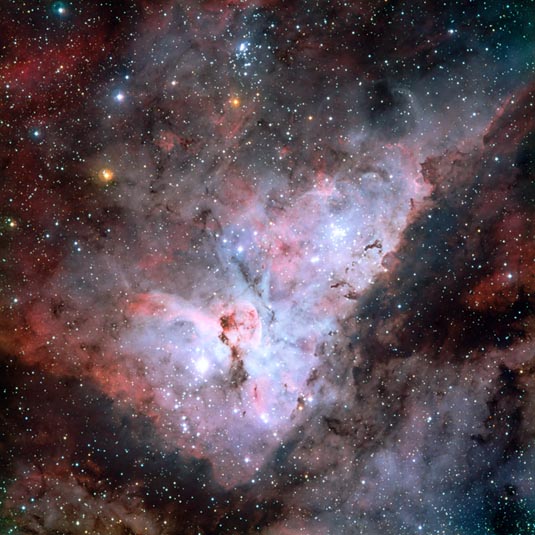
Nebula
RA 10h 45m 3.63s Dec: -59° 41' 4.63"
Carina
7500 light years
70.15 x 69.56 arcminutes
North is 0.2° left of vertical
ESO
12 February 12, 2009
Other: 2000 2007 2009a 2009b 2010 2011a 2011b 2012a 2012b 2018
ABOUT THIS IMAGE:
This is a color-composite image of the Carina Nebula, revealing exquisite details in the stars and dust of the region. It was produced by combining exposures through six different filters from the Wide Field Imager (WFI), attached to the 2.2 m ESO/MPG telescope at ESO's La Silla Observatory, in Chile. Several well known astronomical objects can be seen in this wide field image : to the bottom left of the image is one of the most impressive binary stars in the Universe, Eta Carinae, with the famous Keyhole Nebula just adjacent to the star. The collection of very bright, young stars above and to the right of Eta Carinae is the open star cluster Trumpler 14. A second open star cluster, Collinder 228 is also seen in the image, just below Eta Carinae. The field of view is 0.55 x 0.55 degrees, covering a 72 x 72 light-year region at the distance of the nebula.
The Carina Nebula is located about 7500 light-years away in the constellation of the same name (Carina; the Keel). Spanning about 100 light-years, it is four times larger than the famous Orion Nebula and far brighter. It is an intensive star-forming region with dark lanes of cool dust splitting up the glowing nebula gas that surrounds its many clusters of stars.
The glow of the Carina Nebula comes mainly from hot hydrogen basking in the strong radiation of monster baby stars. The interaction between the hydrogen and the ultraviolet light results in its characteristic red and purple color. The immense nebula contains over a dozen stars with at least 50 to 100 times the mass of our Sun. Such stars have a very short lifespan, a few million years at most, the blink of an eye compared with the Sun's expected lifetime of ten billion years.
One
of the Universe's most impressive stars, Eta Carinae, is found in the
nebula. It is one of the most massive stars in our Milky Way, over 100
times the mass of the Sun and about four million times brighter, making
it the most luminous star known. Eta Carinae is highly unstable, and prone
to violent outbursts, most notably the false supernova event in 1842.
For just a few years, Eta Carinae became the second brightest star in
the night sky and produced almost as much visible light as a supernova
explosion (the usual death throes of a massive star), but it survived.
Eta Carinae is also thought to have a hot companion that orbits around
it in 5.54 years, in an elliptical orbit. Both stars have strong winds,
which collide, leading to interesting phenomena. In mid-January 2009,
the companion was at its closest distance to Eta Carinae. This event,
which may provide a unique insight into the wind structure of the massive
stars, has been followed by a flotilla of instruments on several of ESO's
telescopes.